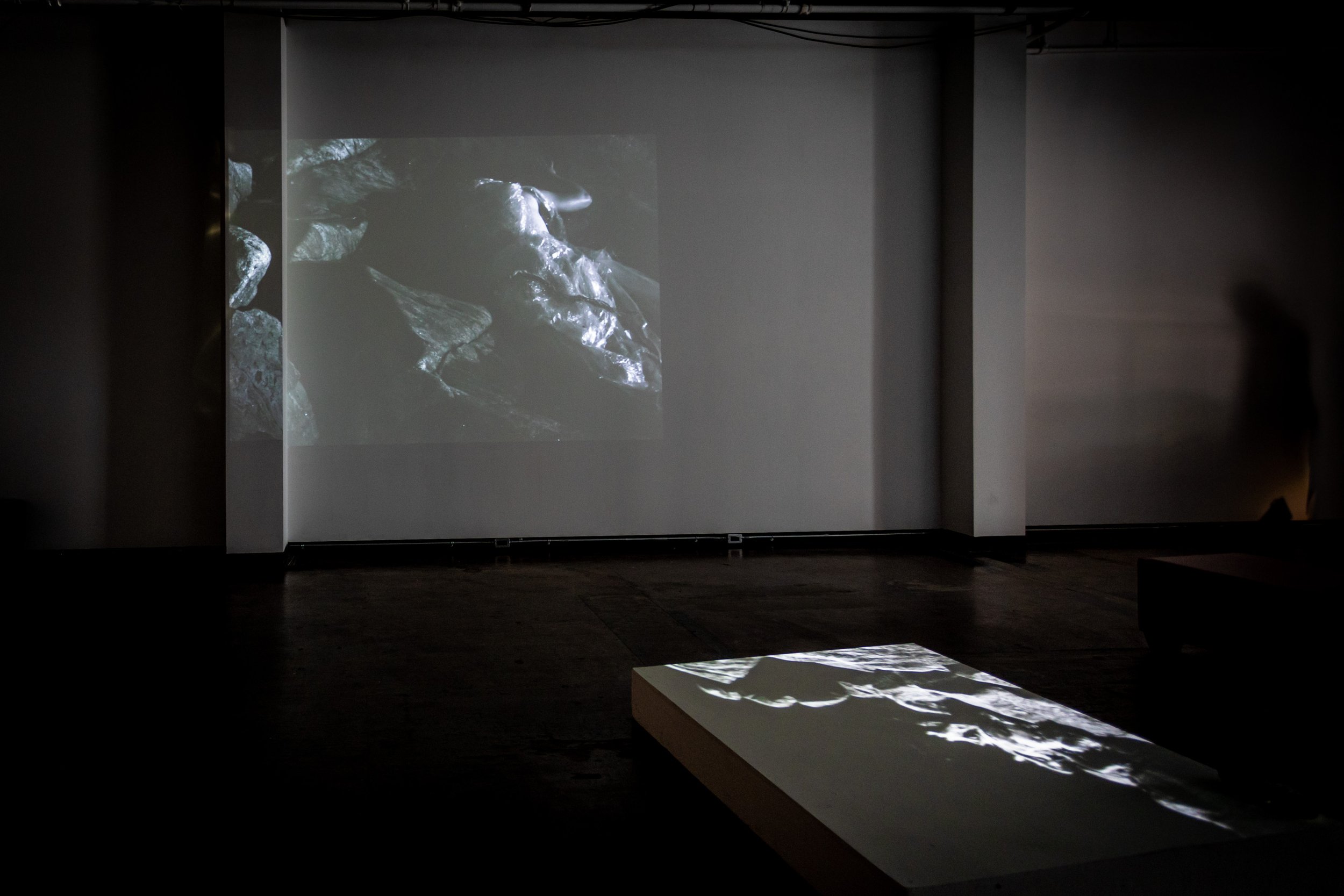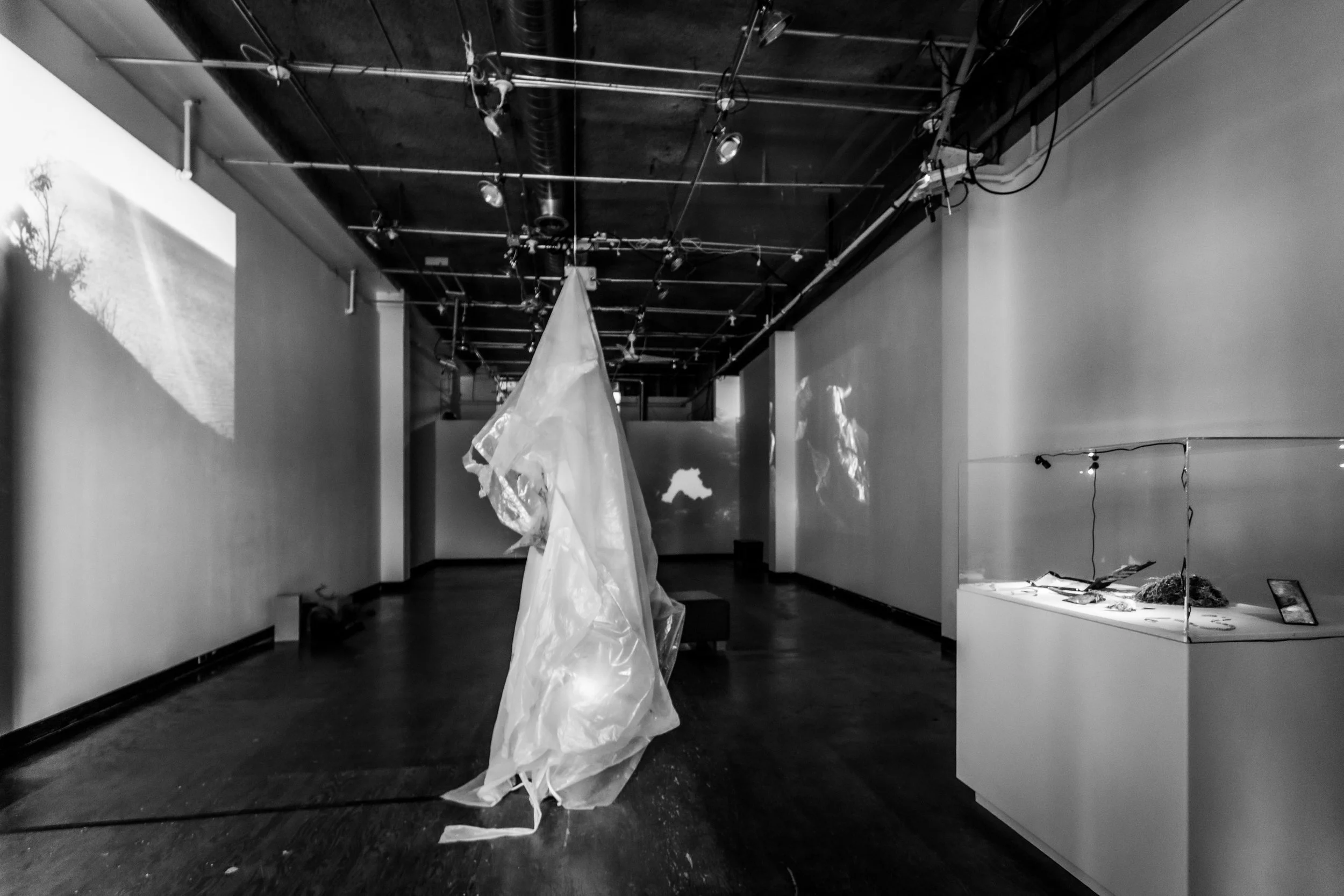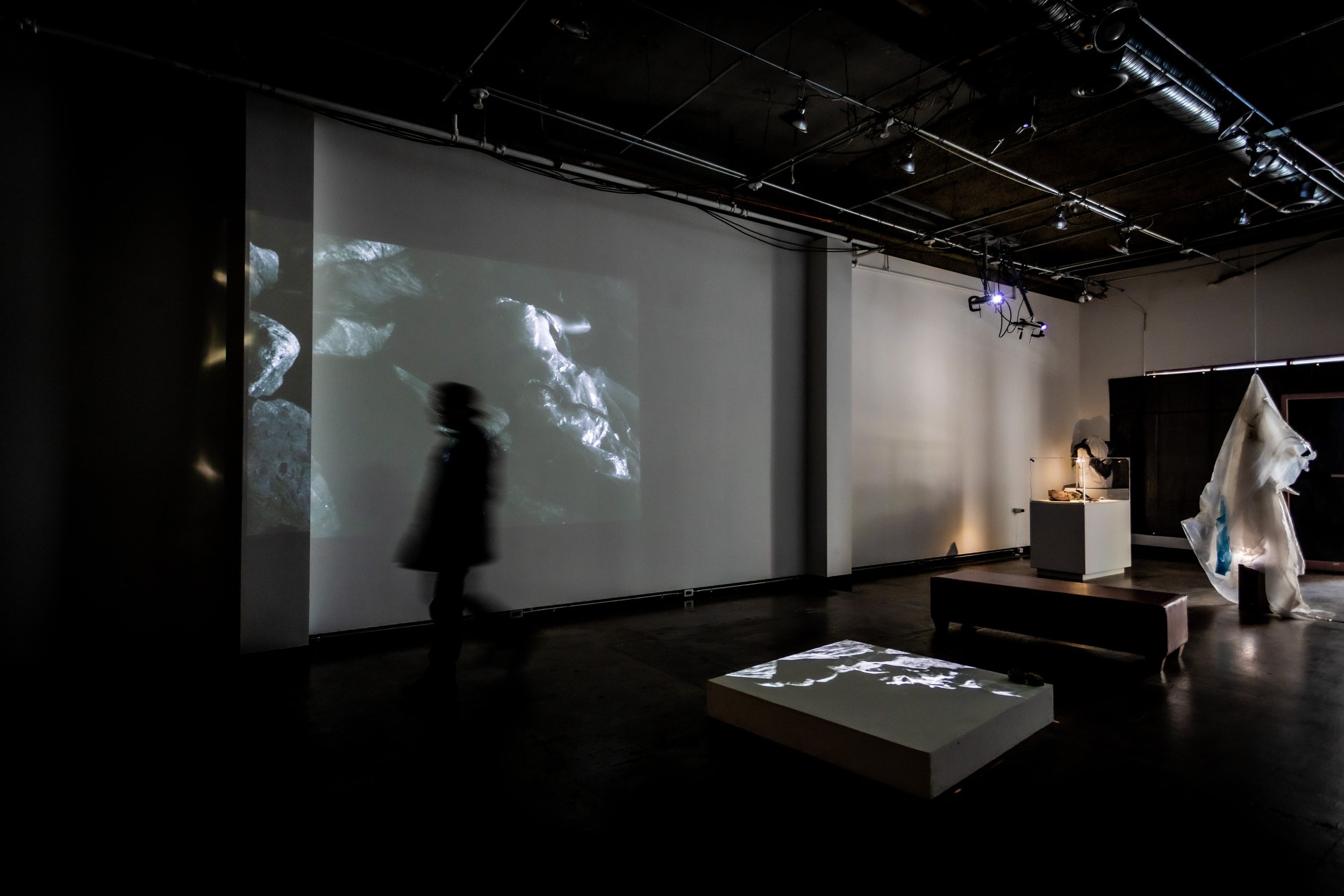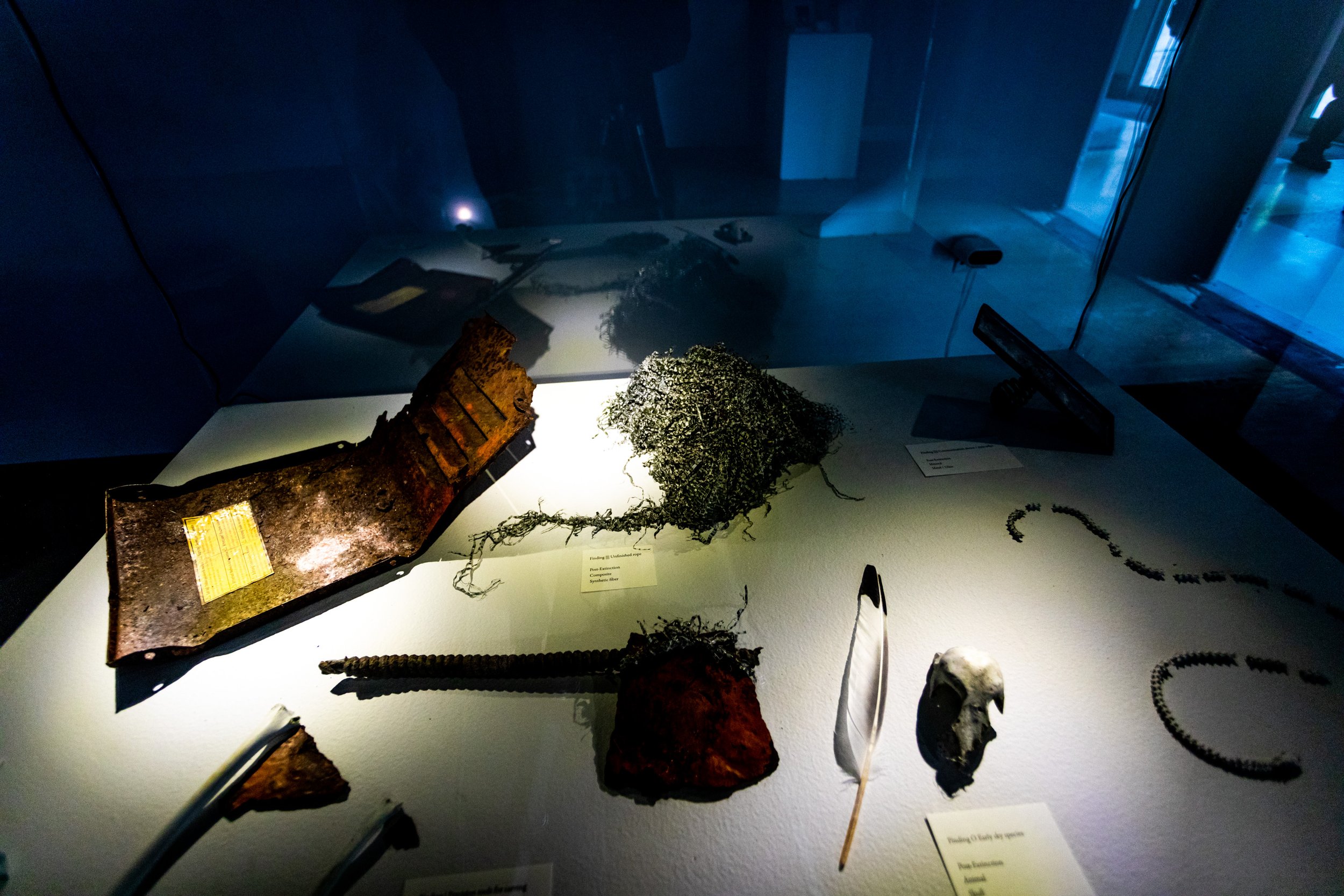Carcass: The Posthistoric Queer
Credit: Daniel Paquet
Elian Mikkola – a Finnish moving image artist of Karelian descent (and Filmpool member) – is busy. They’ve been hopping between Regina, pursuing expanded cinema work and preparing a sessional class on experimental filmmaking at the U of R, and Montreal, where they just picture-locked a SODEC-funded short film in their role as an editor. Before heading to another collaboration at MainFilm in October 2022, they managed to make time for a sit-down with me to discuss their latest installation work: Carcass - The Posthistoric Queer, which recently wrapped its run at Neutral Ground in Regina. A meditation on queer survival, Mikkola’s work takes the far-future point of view of an adaptable survivor looking back upon an eco-apocalypse.
I had the opportunity to experience the installation myself and found it to be an eerie and contemplative experience. Visitors walked into the darkened space at Neutral Ground – the windows to Scarth Street blocked out to control light – and found detritus from the future on display in glass cabinets. We learned these bits of waste are remnants of an ecological disaster – one where queer humans survived and persisted. A muddied, plastic sheet hangs on display from the ceiling. Behind these physical artifacts, we find several projections on the walls and floor: black and white images of an ocean, a rocky shore, and the titular “Carcass”: a human being wrapped in the same plastic sheet, lying in the cold waves.
Then you hear Mikkola’s voice, playing the Carcass, emanating from a PVC pipe on the floor, styled to look like garbage. The narrator's musings felt to me like the last thoughts before death – or a revival. I didn’t stay long enough to see the Carcass rise, and as a result, the piece had the feeling that it was capturing the moment when a person enters the fossil record. I was glad when Mikkola agreed to discuss the piece, the queer canon, and their thoughts on gender transition as an opportunity to re-contextualize the past. They (graciously) assured me these varied possibilities are all part of the medium and their experimentation.
The following interview was lightly edited for clarity.
We've worked together in a moving image context as co-editors. For this piece, it's hard to imagine without all of those constituent parts: all the physical pieces, as well as the projected ones.
Yeah, it's kind of interesting because I'm working on a single-channel version of the same work and I don't know yet if it's going to ever be something to be shown or not.
I think it's hard to think about it without the physical items because they're now so attached to the moving image. And in my mind, it's hard to try to start working with only the moving image. But I find so many interesting points in expanded cinema that takes over a space; that is a little bit more unconventional. And I think those physical, sculptural elements can be added in that viewing experience. That’s something that's really interesting to me in future work right now.
That's what we try to capture through the camera, [the] physicality of the world that we live in. But how does that change when you bring those three-dimensional things? Or parts of the story, into the space? I guess [Carcass is] an exploration of that.
It made me think of museums, paleontological exhibits or archaeology, and I found it interesting that you made a futurism piece exploring a possible future, but it's a moment of departure from the world. It's a moment of death and joining a “future past.”
Yeah, yeah. It's kind of interesting, because this whole exhibition is based on an essay I wrote during the first summer of COVID in 2020, and that is pre-transition time for me. It's interesting that I wrote this without understanding what I was writing about.
But then later on I went through my own transition, gender transition, and it speaks to me now in a very different way than when I was writing it. I think it was just a part of my own kind of self-discovery at the time.
Then these themes of past and present and future. If I take it to the gender analysis side, thinking about trans people's past, there's not a lot of recognition, or archives or documentation , of how we existed in the past. So a lot of trans artists are creating in forms of the future and rediscovering our pasts through future contexts. Kind of reimagining what the past might have been, or what the future looks like, and kind of creating alternative ways of existing in both spaces. And I think I set myself unknowingly to that canon of consideration. That seems to repeat in trans folks’ work quite a bit, but it's understandable, because [of] the space that we're positioned in the world we live in, I guess.
And I find it interesting, like archives – something I use a lot in my work – the past is really motivating to me. So somehow this connection of the past that exists in the future is interesting. So yeah, it kind of relates to everything (laughs).
Credit: Daniel Paquet
It makes me think of these really bad faith, transphobic remarks, right? Like “when you die, what will future people think of your bones?” And a common response now is to say: “well, who cares?” But what I find interesting with Carcass is you're saying: in death, I am a part of this world and the cycle of life. And I find that really beautiful.
Well that's another topic that relates to the canon of works from gender queer artists. This idea of death and rebirth and what we go through when we transition. For example, there is, in a way, a certain part that can be seen as dying, but then again, it's connected to this rebirth and more truthful existence. I also think the idea of dying is interesting, in that context. In this piece specifically, unknowingly, I wrote about my own death in a way that was upcoming, in a symbolic sense.
But there's also this part that is, like, did anything die? Or did it survive? That's kind of the idea behind the piece, too. You know, ultimately, the Carcass rises and walks away and survives. So there's kind of this toying with what other people see. If you stay long enough and dive deep into this moment, and this existence, you will see that there's actually survival underneath, not death.
That's so interesting, because your voice, or the Carcass' voice, often insists that it's time to turn over and it doesn't happen [for so long]. So there's almost this sense of futility, or reflection on one's deathbed, which I found interesting. And if you were to leave before seeing the Carcass resurrect, it's as though you have a voice paired with a fossil, which is not usually what we have, right? You're giving context to this moment of history that an archaeologist wouldn't usually have. I found that fascinating.
That's interesting. As you mentioned, in the gallery, with guests coming in and leaving, without that moment of realization of where the piece is – what is the completion?
You know, I find there's this, I don't want to say power dynamic, but I want this to reward people who do take the time to actually sit down and observe the piece. It's connected to the role that, in the narration, is also given to the person who enters the space.
So the person kind of becomes a part of the story in a way, but then it kind of depends on their actions and what exact part they're going to play in the story if that makes sense.
Credit: Daniel Paquet
Yeah. It's a big difference between, you know, a film where you're controlling every frame of the experience versus this or your past piece, Magdaleena (2020), which also had an interactive audience component. There's more room for an emergent story, I suppose.
A lot of things, and then not many things, from grad school stuck with me. But this one thing did for sure. There was this text we read about film in a gallery space, and what are its possibilities. How does the engagement and the relationship between the viewer and the piece differ from a theatre space? And this idea of the viewer being the editor, entering into a space in the time that they want, and exiting in the time that they want to leave. It's kind of like you're in the role of an editor. That always stuck with me as a thought. And I think that it kind of exists in this piece in the background a little bit.
You filmed in Finland, with your family. Can you talk about what that was like?
(Laughs). I had great collaborators. I like to keep it really tight, and I believe in this kind of restructuring of film sets and I would like to continue pushing this even more in the future, but collaborating with your close ones, your family members, and friends.
Anyways, this one was [shot on a] very rural island that my family has a little cottage on. This is the second film I filmed there. I pictured this space while writing the essay. It was pretty clear that it has to be shot there.
I shot it with the Bolex very DIY, and developed the film in the sauna afterwards with the local sea kale. My mom, together with [my partner] Miranda, are the main collaborators. Unfortunately, the parts that Miranda acted didn't turn up in the film but my mom plays the Carcass half of the time. In the main frame that you see on the floor, it's my mom.
The experience of shooting that, collaborating with my mom, was actually really great. She had top-notch dedication to the role. The water was quite cold. So I tried to keep it really quick. There's a lot of looping that happens. So the time that you see, like, 20 minutes of a loop, but most of the pieces are only like five seconds long.
I didn't anticipate the emotional response I would have seeing my mom in that position. So that was kind of a shock at the time. And I had to keep talking to her the whole time. My visuals were telling me that something was really awfully wrong, and so I had to keep a dialogue the whole time. I wouldn't recommend that again, for anyone. Moving forward, I would probably think about it a little bit more in-depth beforehand.
But honestly, my mom was the one who read the story first and gave some insight. So she's been a very close collaborator in the piece from the beginning. It was suggested [early on] that she'd like to participate in some sense. And since there's reportedly one person, in a way, appearing in the film, it was kind of the plan all the way along to have her. But it was terrible. It was terrible to see her there.
Yeah, I could see that feeling very arresting, the image of her wrapped in plastic on the watery rocks.
It was interesting because then it flipped on the parts that I did. I guess my mom had a similar experience. So we went through this weird kind of visual, and disturbed, experience together.
You'd describe the production experience as “disturbing.”
(Laughs) It was partially disturbing. But we had a very lovely time rowing away from the location and spending this beautiful Finnish, sunny nighttime while rowing. And the seals were hopping around, so like it was pretty great after getting it wrapped.
How did you fund the project, knowing you were going to film in Finland?
Some of it was actually funded by the Finnish Cultural Foundation. I got a grant for eco-processing, and producing, which COVID pushed a lot. I used some of that grant money to fund the materials and small-scale production for this.
I just don't intend to make work that is expensive. (Laughs) So mostly it's just the film and well, when you're collaborating with your family and friends, you're kind of hanging out the whole time. So until they ask me to pay them, I won't. But I will if they do.
Exploit your family to make your movie.
(Laughs) Exactly.
Got it.
They're the best target for that. Don't write any of this. (Both laugh)
How much of the work came together in the installation process? Because I imagine there's a lot you need to plan, but a lot that you can only experience for the first time when it's set up, right?
Yeah, that was a big learning experience for me. Because I haven't done this kind of scale of installation before. And I'm so grateful that I had a little bit over a week to put it together at Neutral Ground. I basically lived in the gallery for the whole time.
There were a lot of technical issues. I need to give credit to Ian Campbell, because he came and helped me out during the biggest, busiest time, installing everything. Even just getting the projectors up to the right position was a hassle. Kyath [Battie] came to help me with that. I had help, which was crucial. Because I thought that I had everything together. But then I had to actually shift the whole ideology behind how the project is being projected in the middle of the week, because the technology just wasn't on my side. So I had to switch to a whole different way of showing it.
The short answer is yes: it was extremely challenging, probably one of the most challenging preparations I've ever done.
Credit: Daniel Paquet
Well, I admire your tenacity to push yourself like that. Is there another medium or project you're thinking of right now to push yourself further?
Well, I don't know. When I got it to work, it was such a rewarding feeling working with projection mapping for pretty much the first time. I did a piece for Nuit Blanche that was projection mapped as well. But this was really the first one that I did on this scale. So it's something that I would like to utilize in the future. It really gave me a spark to use projection mapping together with this analog imagery. And I think there's a lot of potential in the hybrid making there. For me, it's something I want to do in the future.
Although I'd like to skip, as you know, between different worlds. Sometimes I’m in a very single-channel motivated side of things, and then this is a great balance for it. I love the physicality of the gallery, you get to actually explore the space that you're in and utilize it. And projection mapping is something that really has potential in a space.
I've applied for another grant to work with my mom again, on another piece. So hopefully that will come through. And that would involve all of these elements again, so that's maybe the next thing.
Where do you think the post-historic queer Carcass is now, in the world?
Somewhere in the deep future, I guess, or in the deep past? I think that's the thing with circular time. Always present and never to be seen, I guess. Don't quote that. That sounds very ominous and not really understandable.
I mean, we are drinking coffee, not smoking weed. But I think I follow.
I have to mention that all of my work is gifting myself new knowledge about myself. Which sounds very self centred, but I think it just is how I approach making things. And I guess that's where [the Carcass] exists – somewhere in a new pocket of myself, roaming.
I like that a lot. I feel like that's like the truest answer.
The first one was like: I'm trying to explain it in a grandiose way, but this is the more accurate one.
It's what we carry with us when we leave, as an audience. Do you have any advice for filmmakers or artists who want to make this kind of expansive work?
Make it, even before you feel like you know how to make it, because that's how I did this one. I didn't really know how it was going to look until five minutes before people started to come for the opening.
Also the community is very supportive in Regina, the spaces are there and local people are encouraged to propose new ideas for new work. And I feel like that's just like the first step is to hop on those calls for new work to be exhibited in Neutral Ground, or other galleries in the city. Nuit Blanche is a great place to start to experiment with moving image installation work.
That's how I did it. So that would be my only advice.
I think that's helpful advice.
Yeah. Good old “get yourself out there.” (Laughs)
I mean, unfortunately, that's true more often than not so. Thank you so much for doing this and good luck with the next shoot with your mom.
Thank you, Mattias. (Laughs)





